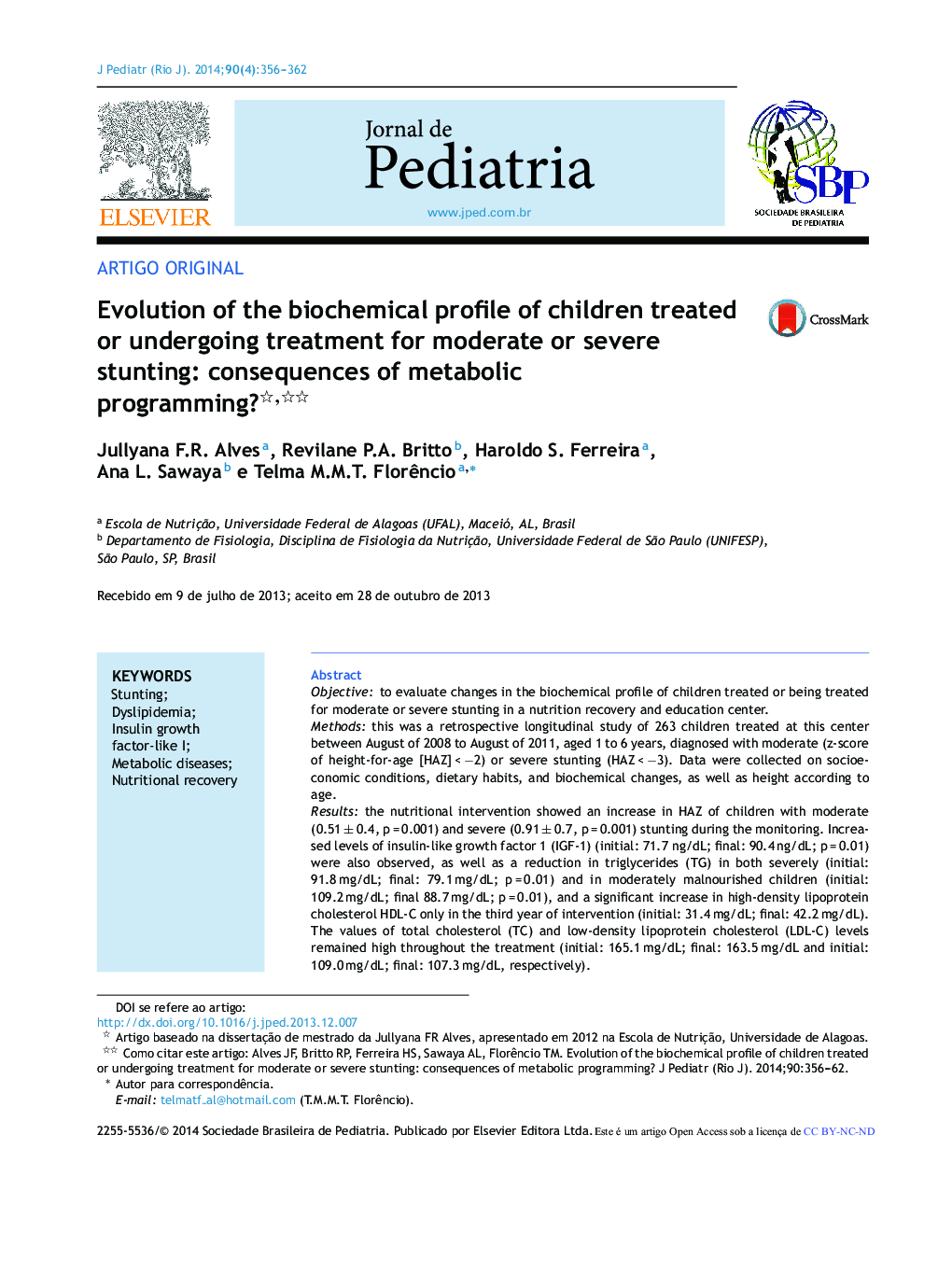| کد مقاله | کد نشریه | سال انتشار | مقاله انگلیسی | نسخه تمام متن |
|---|---|---|---|---|
| 4154495 | 1273714 | 2014 | 7 صفحه PDF | دانلود رایگان |
Objectiveto evaluate changes in the biochemical profile of children treated or being treated for moderate or severe stunting in a nutrition recovery and education center.Methodsthis was a retrospective longitudinal study of 263 children treated at this center between August of 2008 to August of 2011, aged 1 to 6 years, diagnosed with moderate (z‐score of height‐for‐age [HAZ] < −2) or severe stunting (HAZ < −3). Data were collected on socioeconomic conditions, dietary habits, and biochemical changes, as well as height according to age.Resultsthe nutritional intervention showed an increase in HAZ of children with moderate (0.51 ± 0.4, p = 0.001) and severe (0.91 ± 0.7, p = 0.001) stunting during the monitoring. Increased levels of insulin‐like growth factor 1 (IGF‐1) (initial: 71.7 ng/dL; final: 90.4 ng/dL; p = 0.01) were also observed, as well as a reduction in triglycerides (TG) in both severely (initial: 91.8 mg/dL; final: 79.1 mg/dL; p = 0.01) and in moderately malnourished children (initial: 109.2 mg/dL; final 88.7 mg/dL; p = 0.01), and a significant increase in high‐density lipoprotein cholesterol HDL‐C only in the third year of intervention (initial: 31.4 mg/dL; final: 42.2 mg/dL). The values of total cholesterol (TC) and low‐density lipoprotein cholesterol (LDL‐C) levels remained high throughout the treatment (initial: 165.1 mg/dL; final: 163.5 mg/dL and initial: 109.0 mg/dL; final: 107.3 mg/dL, respectively).Conclusionthe nutritional treatment for children with short stature was effective in reducing stunting and improving TG and HDL‐C after three years of intervention. However, the levels of LDL‐C and TC remained high even in treated children. It is therefore speculated that these changes may result from metabolic programming due to malnutrition.
ResumoObjetivoavaliar as mudanças no perfil bioquímico de crianças tratadas ou em tratamento para déficit estatural moderado ou grave em um centro de recuperação e educação nutricional.Métodosestudo longitudinal retrospectivo com 263 crianças semi‐internas no Centro no período de agosto/2008 a agosto/2011, com idade entre 1 e 6 anos e diagnóstico de déficit estatural moderado, escore‐Z da altura‐para‐idade (AIZ) < −2 e grave (AIZ < −3). Foram coletados dados socioeconômicos, dietéticos e bioquímicos e a evolução estatural segundo a idade.Resultadoscom a intervenção nutricional observou‐se incremento no escore‐z das crianças com déficit estatural moderado (0,51 ± 0,4; p = 0,001) e grave (0,91 ± 0,7; p = 0,001) durante o período de acompanhamento. Observou‐se, ainda, aumento nos níveis de fator de crescimento insulina‐símile (IGF‐1) (inicial: 71,7 ng/dL; final: 90,4 ng/dL; p = 0,01), redução nos triglicérides (TG) tanto nas crianças graves (inicial: 91,8 mg/dL; final: 79,1 mg/dL; p = 0,01) como nas moderadamente desnutridas (109,2 mg/dL para 88,7 mg/dL; p = 0,01) e aumento significativo do lipoproteína de alta densidade (HDL‐C) apenas no terceiro ano de intervenção (inicial: 31,4 mg/dL; final: 42,2 mg/dL). Os valores de colesterol total (CT) e lipoproteína de baixa densidade (LDL‐C) continuaram elevados durante todo o tratamento (inicial: 165,1 mg/dL; final: 163,5 mg/dL e inicial: 109,0 mg/dL; final: 107,3 mg/dL, respectivamente).Conclusãoo tratamento nutricional para as crianças de baixa estatura mostrou‐se eficaz na redução do déficit estatural e dos TG e melhora dos níveis de HDL‐C após três anos de intervenção. Porém, os níveis de LDL‐C e CT mostraram‐se sempre elevados mesmo nas crianças tratadas. Questiona‐se, pois, se essas alterações seriam resultantes da programação metabólica a desnutrição.
Journal: Jornal de Pediatria (Versão em Português) - Volume 90, Issue 4, July–August 2014, Pages 356–362
